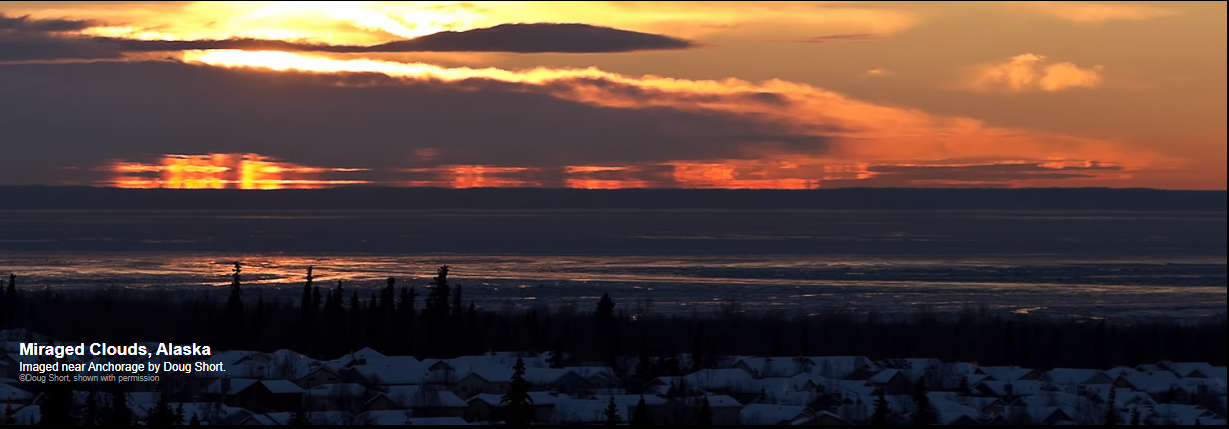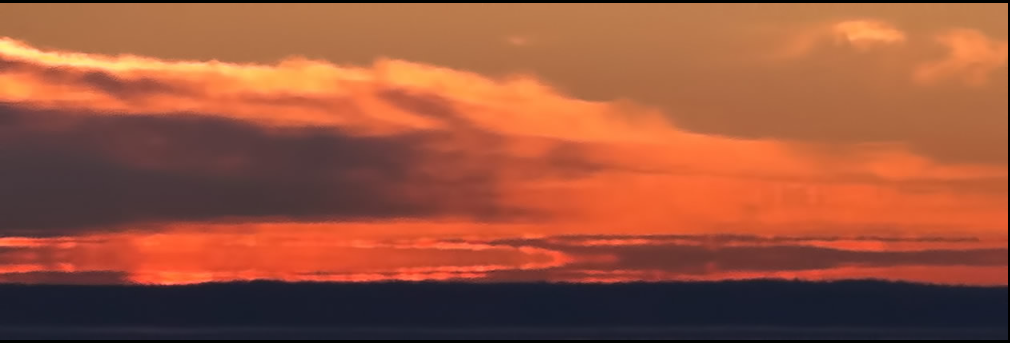OPOD - Cloud Mirage
OPOD - Cloud Mirage: A Fascinating Atmospheric Phenomenon
Cloud mirages, also known as superior mirages, are mesmerizing optical illusions that occur in the Earth's atmosphere. These phenomena create a captivating spectacle where the appearance of clouds is distorted, forming multiple images and inverted reflections. While we have a basic understanding of how these mirages form, the intricate details behind their occurrence continue to astound scientists and enthusiasts alike.
Unveiling the Mirage: A Closer Look at Superior Mirages
One such example of a cloud mirage was captured near Anchorage, Alaska by photographer Doug Short. The image showcases a remarkable display of clouds, seemingly doubled with an inverted reflection of the upper clouds. In the photograph, one can also observe distant hills, adding an extra layer of intrigue to the scene.
The key to understanding cloud mirages lies in temperature inversions, where warmer air sits above cooler air. This atmospheric condition is responsible for the superior mirage effect, aptly named because it produces an inverted image above the normal one. Let's delve deeper into the science behind this captivating phenomenon.
Decoding the Science: Rays and Refractions
To comprehend the formation of cloud mirages, it is crucial to analyze the behavior of light rays as they pass through the atmosphere. When rays leave the top of a cloud and travel towards our eyes, they encounter cool air with relatively constant temperature. As a result, these rays experience minimal deviation, allowing us to perceive the cloud in its correct position.
However, a different scenario unfolds when rays enter a temperature inversion layer characterized by varying temperature and density gradients. In such cases, rays are refracted towards denser (cooler) air layers, causing them to curve downward towards our eyes. Consequently, a second image of the cloud top is formed above the one seen by rays traveling through the cool air. This creates an intriguing visual phenomenon where the upper image appears inverted.
The Complexity of Superior Mirages
While the basic formation of cloud mirages is understood, these atmospheric phenomena can exhibit a range of complexities. Well-developed superior mirages often present a third erect image above the second inverted one, further enhancing their captivating nature. In some instances, these mirages can even resemble Fata Morgana, characterized by towering images that resemble cliffs or castles suspended in the air. The photograph captured by Doug Short near Anchorage exhibits elements reminiscent of Fata Morgana, adding to its allure.
A World of Imagination in the Clouds
As Charles M. Schulz beautifully illustrated in his Peanuts comic strip, clouds have the power to stimulate our imagination. The ever-changing shapes and formations of clouds provide a canvas for our minds to conjure up various interpretations. Whether you see familiar objects or abstract patterns, the beauty of clouds lies in their ability to inspire wonder and creativity.
Embracing the Mysteries of Atmospheric Optics
Cloud mirages, such as the one captured in Alaska, offer us a glimpse into the fascinating world of atmospheric optics. While we continue to uncover the scientific principles behind these phenomena, there is still much to explore and understand. The interplay between temperature inversions, refraction of light rays, and the resulting mirage formations is an ongoing area of research that captivates scientists and atmospheric enthusiasts alike.
As we marvel at the wonders of cloud mirages, let us embrace the mysteries that lie within our atmosphere. These captivating optical illusions remind us of the intricacies and complexities that surround us, constantly urging us to delve deeper into the enigmatic realm of atmospheric optics. So next time you find yourself gazing at the clouds, allow your imagination to soar and appreciate the hidden wonders that await discovery in the ever-changing sky above.

Miraged Clouds, Alaska
Imaged near Anchorage by Doug Short.
©Doug Short, shown with permission

The near horizon clouds are doubled with the upper ones inverted. There are apparently also distant hills.
“I spotted this mirage one evening as the sun was setting. There are no mountains or hills in this direction. The relatively thin strip of land below the mirage is the Kenai (keen' eye') Peninsula south of Anchorage. The sun was just barely above to slightly below the horizon.”
A temperature inversion with warmer air above cooler was responsible for the superior mirage, ‘superior’ because there is an inverted image above the lower ‘normal’ one.
Regard the lower cloud in the ray diagram. Rays can leave the cloud top along path ‘a’ towards the eye. The ray passes through cool air of more or less constant temperature and is little deviated. The cloud top appears in the 'right' position. However, a second ray ‘b’ enters the temperature and density gradients of the inversion layer. Rays are always deviated towards the denser (cooler) air layer and ray ‘b’ curves downwards to the eye. It forms a second image of the cloud top above that seen by ray ‘a’. Rays leaving the cloud base can in the right circumstances be even more strongly refracted. Ray ‘c’ from the cloud base appears to come from high in the sky. The upper image is inverted.
Well-developed superior mirages have a third erect image above the second inverted one. They can also show Fata Morgana characteristics with towering images resembling cliffs or castles in the air. Something of the sort is possibly happening here.
Lucy: Aren't the clouds beautiful? They look like big balls of cotton. I could just lie here all day and watch them drift by. If you use your imagination, you can see lots of things in the cloud's formations. What do you think you see, Linus?
Linus: Well, those clouds up there look to me look like the map of the British Honduras on the Caribbean. That cloud up there looks a little like the profile of Thomas Eakins, the famous painter and sculptor. And that group of clouds over there gives me the impression of the Stoning of Stephen. I can see the Apostle Paul standing there to one side.
Charlie Brown: Well... I was going to say I saw a duckie and a horsie, but I changed my mind.
From Peanuts by Charles M. Schulz
Note: this article has been automatically converted from the old site and may not appear as intended. You can find the original article here.
Reference Atmospheric Optics
If you use any of the definitions, information, or data presented on Atmospheric Optics, please copy the link or reference below to properly credit us as the reference source. Thank you!
-
<a href="https://atoptics.co.uk/blog/opod-cloud-mirage/">OPOD - Cloud Mirage</a>
-
"OPOD - Cloud Mirage". Atmospheric Optics. Accessed on November 26, 2024. https://atoptics.co.uk/blog/opod-cloud-mirage/.
-
"OPOD - Cloud Mirage". Atmospheric Optics, https://atoptics.co.uk/blog/opod-cloud-mirage/. Accessed 26 November, 2024
-
OPOD - Cloud Mirage. Atmospheric Optics. Retrieved from https://atoptics.co.uk/blog/opod-cloud-mirage/.